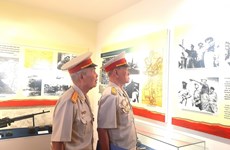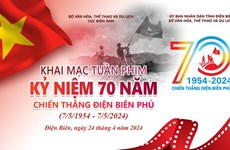Coffin caves in Suoi Bang commune – archaeological treasure
The remote rural commune of Suoi Bang in Van Ho district, the northern
mountainous province of Son La, is a popular destination for adventure
and discovery tourism not only for its natural beauty but also for the
mystery existence of caves full with ancient hanging coffins, with
remains found to date back to 1,240 years ago.
The remote rural commune of Suoi Bang in Van Ho district, the northern
mountainous province of Son La, is a popular destination for adventure
and discovery tourism not only for its natural beauty but also for the
mystery existence of caves full with ancient hanging coffins, with
remains found to date back to 1,240 years ago.
Around 80 such caves are located in a rocky mountain range called Ma Lang Chanh (roughly translated as Ancient Ghost Cave Mountain) by locals with the largest number found in Na Loi village at the centre of Suoi Bang.
Communal authorities said surveys conducted by Vietnamese archaeologists since 2007 discovered some more coffin caves in nearby mountains.
Coffins are only found in caves in dangerously high cliffs along water bodies and facing the east. Researchers said such a location is meant to prevent other ethnic groups or beasts from damaging the coffins, and help preserve remains in good conditions since the mouth of caves would receive much wind and sunlight.
The number of coffins varies from cave to cave, ranging from one to 36. The coffins were made by cutting out the inside of a tree trunk and lidded with the other half of the trunk, which were said to represent boats that would carry the dead’s soul to their ancestors.
Na Loi cave in Mount Cum Tay is found to have the most number of coffins, 36, two of which still contain shin bones, a rib, skulls, and four teeth, the Museum of Son La province said.
Meanwhile at nearby Tang Me cave, researchers discovered 30 coffins with one containing one skull and several bone fragments, it added.
Coffins were hung close to the cave ceiling with one end put into a rock hollow and the other placed on props in the shape of buffalo horns.
Experts also found a number of holed shells inside some coffins, which were believed to be used to make jewelery.
However, due to time and human impacts, almost all coffins and remains inside have been damaged.
Until now, real owners of hanging coffins in Suoi Bang remain a mystery to researchers.
Basing on the above-mentioned evidence, some researchers thought hanging coffins in Suoi Bang belonged to residents living near water bodies and practising agriculture.
Local legend has it that in the past, when Thai people migrated to Son La’s Moc Chau area, they fought with Xa ethnics for land and then decided to shoot arrows to solve the dispute. Whose arrows hit the rock slope, it meant the Mountain and Land Gods allowed that ethnic group to reside.
They stood on Mount Cam Ten (Fixing Arrows) in Muong Sang commune and fired arrows towards Suoi Bang. With beeswax-covered heads, Thai’s arrows stuck onto the mountain while those of the Xa bounced back as their arrows’ heads were covered with bronze. So the Xa had to leave and before going, they hid their ancestors’ coffins in caves high on mountains.
Another legend said such coffins contained remains of Xa people, a tribe of cannibals having a tattooing tradition.
Other researcher said hanging coffins might belong to ancient Dao people, arguing that the Red Dao ethnic group have been inhabiting land surrounding the upper Da River, traversing Son La province, for generations. They were skilled at both making dugouts and climbing mountains.
Assoc.Prof. Dr Nguyen Lan Cuong from the Vietnam Institute of Archaeology said coffin caves in Suoi Bang embody cultural, faith and anthropological values of ancient people that need to be preserved for further study.
The cave system was recognised as a national relic site by the Ministry of Culture, Sports and Tourism in March 2014.-VNA
Around 80 such caves are located in a rocky mountain range called Ma Lang Chanh (roughly translated as Ancient Ghost Cave Mountain) by locals with the largest number found in Na Loi village at the centre of Suoi Bang.
Communal authorities said surveys conducted by Vietnamese archaeologists since 2007 discovered some more coffin caves in nearby mountains.
Coffins are only found in caves in dangerously high cliffs along water bodies and facing the east. Researchers said such a location is meant to prevent other ethnic groups or beasts from damaging the coffins, and help preserve remains in good conditions since the mouth of caves would receive much wind and sunlight.
The number of coffins varies from cave to cave, ranging from one to 36. The coffins were made by cutting out the inside of a tree trunk and lidded with the other half of the trunk, which were said to represent boats that would carry the dead’s soul to their ancestors.
Na Loi cave in Mount Cum Tay is found to have the most number of coffins, 36, two of which still contain shin bones, a rib, skulls, and four teeth, the Museum of Son La province said.
Meanwhile at nearby Tang Me cave, researchers discovered 30 coffins with one containing one skull and several bone fragments, it added.
Coffins were hung close to the cave ceiling with one end put into a rock hollow and the other placed on props in the shape of buffalo horns.
Experts also found a number of holed shells inside some coffins, which were believed to be used to make jewelery.
However, due to time and human impacts, almost all coffins and remains inside have been damaged.
Until now, real owners of hanging coffins in Suoi Bang remain a mystery to researchers.
Basing on the above-mentioned evidence, some researchers thought hanging coffins in Suoi Bang belonged to residents living near water bodies and practising agriculture.
Local legend has it that in the past, when Thai people migrated to Son La’s Moc Chau area, they fought with Xa ethnics for land and then decided to shoot arrows to solve the dispute. Whose arrows hit the rock slope, it meant the Mountain and Land Gods allowed that ethnic group to reside.
They stood on Mount Cam Ten (Fixing Arrows) in Muong Sang commune and fired arrows towards Suoi Bang. With beeswax-covered heads, Thai’s arrows stuck onto the mountain while those of the Xa bounced back as their arrows’ heads were covered with bronze. So the Xa had to leave and before going, they hid their ancestors’ coffins in caves high on mountains.
Another legend said such coffins contained remains of Xa people, a tribe of cannibals having a tattooing tradition.
Other researcher said hanging coffins might belong to ancient Dao people, arguing that the Red Dao ethnic group have been inhabiting land surrounding the upper Da River, traversing Son La province, for generations. They were skilled at both making dugouts and climbing mountains.
Assoc.Prof. Dr Nguyen Lan Cuong from the Vietnam Institute of Archaeology said coffin caves in Suoi Bang embody cultural, faith and anthropological values of ancient people that need to be preserved for further study.
The cave system was recognised as a national relic site by the Ministry of Culture, Sports and Tourism in March 2014.-VNA











